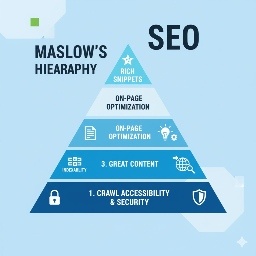Are you a recent graduate, a passionate freelancer, or someone looking to switch into the high-paying world of digital growth? You need to understand SEO marketing. SEO (Search Engine Optimization) is the engine that drives sustainable, free traffic to any website. It is not just a buzzword—it is the most crucial skill set in modern digital marketing. This deep dive will break down the strategies, frameworks, and tools you need to master this field, get noticed by employers, and secure high-value clients.
1. Why SEO Marketing is Your Best Career Move
In a world saturated with paid ads, organic search traffic is the gold standard. When a user finds you via a search engine, the trust and intent are significantly higher. For you, this means high demand and job security.
| Audience | Why SEO is Crucial |
|---|---|
| Freshers & Passed Out | SEO roles are plentiful, offer fast career progression, and don't always require a specific degree—just practical skills. |
| Career Switchers | It bridges creative and analytical skills, offering a clear path from other fields like journalism, IT, or analysis. |
| Freelancers | It's the most high-value service you can offer clients, delivering measurable ROI and long-term contracts. |
In a world saturated with paid ads, organic search traffic is the gold standard. When a user finds you via a search engine, the trust and intent are significantly higher. For you, this means high demand and job security.2. The Foundation: Maslow’s Hierarchy of SEO Needs
To truly master SEO marketing, you must understand the proper order of operations. You cannot chase modern features before establishing core functionality. This framework ensures you build your digital foundation correctly, from the ground up.

Level 1: Crawl Accessibility & Security
- +Need: Can search engines (like Google) find and read your pages?
- +Action: Ensure your site loads fast (speed), is secure (HTTPS), and has a clean, up-to-date sitemap and robots.txt file.
Level 2: Indexability
- +Need: Once found, is the page actually allowed to be stored in the search engine's database (the index)?
- +Action: Use proper canonical tags and avoid using noindex tags unless absolutely necessary.
Level 3: Great Content & Keyword Targeting
- +Need: Does your content actually satisfy the user's search intent?
- +Action: Perform thorough SEO marketing keyword research to understand what your target audience is searching for. Create engaging, unique, and long-form content that fully answers their queries.
Level 4: Keywords, User Intent, & On-Page Optimization
- +Need: Is the content optimized so search engines know exactly what it's about?
- +Action: Strategic placement of your primary keyword in the first paragraph, subheadings (H2, H3), and image alt text. Optimize the user experience (UX) to reduce bounce rate.
Level 5: Title Tags, Schema, & Rich Snippets (The Apex)
- +Need: Does your result stand out on the SERP (Search Engine Results Page)?
- +Action: Craft compelling, click-worthy Title Tags and Meta Descriptions. Implement structured data (Schema Markup) to earn rich snippets (e.g., star ratings, FAQs) that attract more clicks.
3. The Four Pillars: Types of SEO
A complete SEO marketing strategy involves four distinct but interconnected types of optimization.

A. Technical SEO
This focuses on the non-content aspects of your site. It ensures search engines can efficiently crawl and index your site
- + Key Tasks: Site speed optimization, mobile-friendliness, managing broken links, creating XML Sitemaps, and implementing structured data (Schema).
B. On-Page SEO
This focuses on optimizing the content and HTML source code of a specific page.
- + Key Tasks: Keyword research, title tag and meta description optimization, content quality, image optimization, internal linking, and URL structure.
C. Off-Page SEO
This involves activities done outside your website to establish authority and trust (Domain Authority).
- +Key Tasks: Backlink building (earning links from other credible sites), social media marketing, and brand mentions.
D. Local SEO
Crucial for businesses with a physical location or those targeting local customers.
- + Key Tasks: Optimizing your Google Business Profile (formerly GMB), building local citations, and managing online reviews.
4. Winning Strategies in Digital Marketing
To implement an effective SEO marketing plan, integrate these three powerful strategies into your overall digital marketing efforts.
Strategy 1: The Topic Cluster Model
Instead of creating isolated pages, organize your content into clusters. You have one central "Pillar Page" (a broad, comprehensive guide) that links to multiple detailed "Cluster Pages" (specific articles on subtopics). This signals to Google that you are a comprehensive authority on the whole topic, leading to higher rankings for all linked pages.
Strategy 2: High-Quality Link Building
Backlinks (links from other websites to yours) are still one of the most powerful ranking factors. Focus on quality over quantity.
- + Key Tasks: Optimizing your Google Business Profile (formerly GMB), building local citations, and managing online reviews.
Strategy 3: AI Overview & SERP Feature Optimization
With the rise of generative AI features in search, the goal is to be the primary source Google cites.
- + Action for AI Overview Rank: Use ultra-clear, concise summaries at the top of your articles; structure content using clear Q&A formats; and use Schema markup (especially FAQ and HowTo) to feed data directly to search engines. Your content should be the single best answer to a query.
5. Essential SEO Marketing Tools

These tools are non-negotiable for serious work in SEO marketing. Get familiar with their free versions now—they are the bread and butter of your daily tasks.
| Tool Category | Tool Name | Best For | Why You Need It |
|---|---|---|---|
| Core Analytics | Google Search Console (GSC) | Indexing, Performance | Shows exactly how Google sees your site; tracks ranking keywords and crawl errors. (FREE) |
| Core Analytics | Google Analytics 4 (GA4) | User Behavior | Measures traffic, conversions, and how users interact with your content (time on page, bounce rate). (FREE) |
| Keyword/Competitor | Semrush / Ahrefs | Keyword Research, Audits | The industry standard for finding high-potential keywords and analyzing competitor strategies. |
| On-Page Optimization | Surfer SEO / Clearscope | Content Quality & Density | Helps you optimize content based on top-ranking competitor data, ensuring comprehensive coverage. |
| Technical Check | PageSpeed Insights | Site Speed | Analyzes and provides actionable recommendations to fix slow load times. (FREE) |
Conclusion: Starting Your SEO Marketing Journey
SEO marketing is a continuous, long-term game, but the rewards are significant. You now have the full roadmap: the strategic Maslow's Hierarchy of SEO Needs, the four types of SEO, the winning strategies in digital marketing, and the essential tools
Your next steps:
- 1Get Certified: Complete the free courses offered by Google (GSC and GA4).
- 2Practice: Start a small personal blog or offer a free audit to a small local business.
- 3Specialise: Once you grab the basics, decide if you prefer the technical side, the content side, or the link-building side.
The demand for skilled SEO professionals is only growing. Start today, and you will quickly position yourself as an invaluable asset in the digital world!
Have questions , need personalized SEO guidance , or want help growing your website traffic?
We’d love to hear from you!


